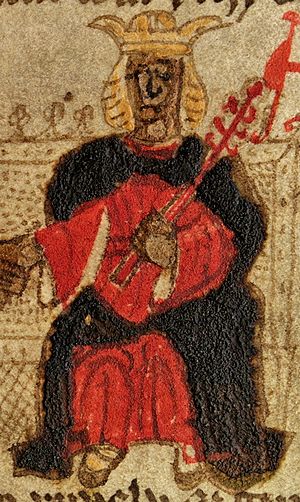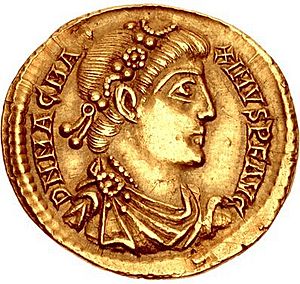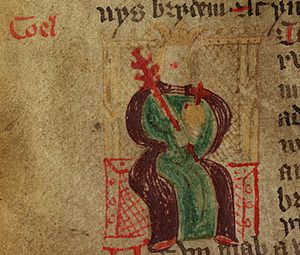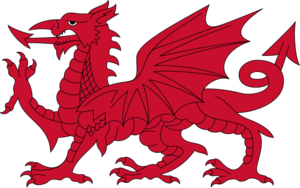Cunedda facts for kids
Quick facts for kids Cunedda ap Edern |
|
|---|---|

Crop Cunedda from File History of the Kings
|
|
| King of Gwynedd | |
| Reign | c. 450–460 |
| Born | 386 Manaw Gododdin |
| Died | 460 (74 years) Gwynedd, modern-day Wales |
| Spouse | Gwawl Verch Coel |
| Father | Eternus (Edeyrn) |
Cunedda ap Edern, also known as Cunedda Wledig, was a very important leader in early Wales. He lived in the 400s. Cunedda started the royal family of Gwynedd, which is one of the oldest royal families in Europe. He was also a strong military leader for the Roman Empire and was linked to the Red Dragon symbol.
Contents
What's in a Name?
The name Cunedda comes from an old British word. It means "Good Hound/Warrior" or "Having Good Hounds/Warriors." This name was written as Cunedag in an old book from the year 828 called Historia Brittonum.
Cunedda's Family Tree
Cunedda's family history goes back to his grandfather, Padarn Beisrudd. Padarn lived in Roman Britain during the late Roman times. His name means "Paternus of the red tunic" or "scarlet cloak." Red was a special color for Roman officers. It was second only to the purple color worn by Emperors.
Padarn might have been a Roman official. He may have led troops called the Votadini in Scotland around the 380s. Or, he could have been a local leader given a Roman military rank. After Padarn, his son Edern (Cunedda's father) likely took command. Then, Cunedda took over. He later became the first King of Gwynedd.
Cunedda's family tree also connects to very old ancestors. One was Afallach ap Beli Mawr, son of Beli Mawr. Beli Mawr was the father of King Cassivellaunus. Cassivellaunus was a real person who fought against Julius Caesar when Caesar invaded Britain in 54 BC. Cunedda and his father-in-law, King Coel Hen, were both said to be male-line descendants of Beli Mawr.
Cunedda's Life
Moving to Wales

Old Welsh stories say that Cunedda came from Manaw Gododdin. This area is now in Scotland. The stories say Cunedda and his eight sons came from the north. They drove out invaders from Ireland, called the Scotti.
Cunedda and his family led the Votadini troops. They fought against invaders from Pictland and Ireland. Later, Cunedda's troops moved to North Wales. They went there to defend the area from Irish invaders. Cunedda settled in Wales, in the area of the Venedoti. This area later became the center of the Kingdom of Gwynedd.
Historians have different ideas about why Cunedda moved. Some think he was following orders from Roman leaders like Magnus Maximus. Others believe he was working for Vortigern, a powerful British king after the Romans left. It is hard to know for sure because the Roman Empire's power in Britain was ending.
Family and Successors

We don't know much about Cunedda himself. He was probably known for his strength and bravery. He married Gwawl, the daughter of King Coel Hen. King Coel Hen ruled Eboracum (modern York). Cunedda is said to have had nine sons. Two early kingdoms, Ceredigion and Meirionnydd, were supposedly named after his sons, King Ceredig and King Meirion.
Cunedda's great-grandson was Maelgwn Gwynedd. Maelgwn died in 547. If we count back from that date, it suggests Cunedda lived in the mid-400s.
Allt Cunedda Hill
The hill called Allt Cunedda is near Cydweli in Carmarthenshire. It might be connected to Cunedda. This suggests he may have fought against Irish groups in southwest Wales too.
In the 1800s, people dug at this site. They found an Iron Age hill fort. They also found stone graves with skeletons of large men. Some bones were sent to museums but are now lost. One burial mound was called Banc Benisel. It was said to be the grave of Sawyl Penuchel, a legendary king.
It's possible Cunedda himself was buried at Allt Cunedda. This site was important for a long time, even after the Romans left. Local stories suggest people respected this historic place. There is also a legend that Cunedda was defeated and killed near Cydweli and is buried under Allt Cunedda.
Cunedda's Family

Immediate Ancestors
- Eternus (Edeyrn): Cunedda's father, a commander of the Votadini troops.
- Paternus (Padarn Beisrudd): Cunedda's grandfather, also a commander of the Votadini troops.
- Tacitus (Tegid): Cunedda's great-grandfather.
Children
- Rhufon: Ruler of the Kingdom of Rhufoniog.
- Dunod: Ruler of the Kingdom of Dunoding.
- Ceredig: King of the Kingdom of Ceredigion, and grandfather of Bishop Saint David.
- Einion: Ruler of Gwynedd, and grandfather of King Cadwallon Lawhir ap Einion.
- Dogfael: King of the small Kingdom of Dogfeiling.
- Edern: Ruler of the minor Kingdom of Edeirnion under Gwynedd.
- Also, Tybion, Ysfael, and Afloeg.
Great-Grandson
Maelgwn Gwynedd: King of Gwynedd. He was called "Dragon" by a writer named Gildas. Maelgwn was an ancestor of King Cadwaladr, who also used the Red Dragon symbol. This Red Dragon symbol was later brought to England by the House of Tudor. They were descendants of Cunedda through Owen Tudor and King Henry Tudor. The Red Dragon is now on the Flag of Wales.
See also
 In Spanish: Cunedda para niños
In Spanish: Cunedda para niños
- Kings of Wales family trees

